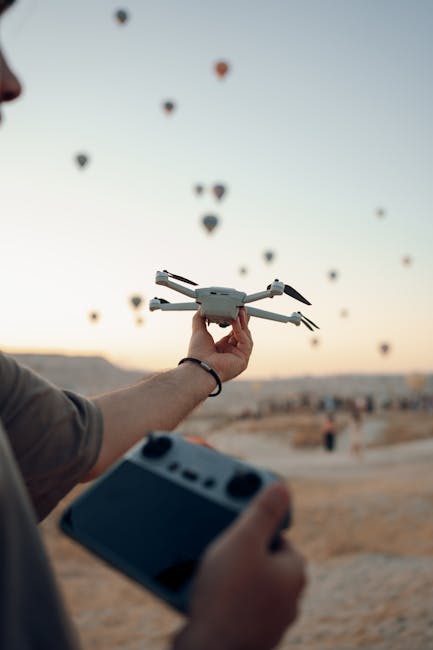
Introduction
The advent of autonomous drones technology has transformed numerous sectors from agriculture to logistics, enhancing efficiency and operational safety. With the integration of AI in drones, these unmanned aerial vehicles are becoming smarter, capable of making autonomous decisions that significantly improve drone flight operations. This article explores how artificial intelligence applications are revolutionizing flight operations in autonomous drones, focusing on the enhanced safety and efficiency they offer.
The Role of AI in Drones
AI in drones plays a pivotal role in enabling these machines to perform complex tasks without human intervention. By leveraging advanced algorithms and machine learning, drones equipped with artificial intelligence can analyze vast amounts of data in real-time to make informed decisions. This capability is crucial for applications ranging from surveillance and delivery to search and rescue operations.
Autonomous Drones Technology
At the core of autonomous drones technology lies the integration of AI, which allows for automated navigation and obstacle detection. These drones utilize sensors and cameras to gather environmental data, which is processed using AI algorithms. As a result, they can adapt their flight paths to avoid obstacles, ensuring safe and efficient operations.
Improving Drone Flight Operations
- Enhanced Navigation: AI enables drones to create dynamic maps in real-time, facilitating better route planning and navigation.
- Obstacle Avoidance: Advanced machine learning algorithms help drones detect and avoid obstacles, reducing the risk of collisions.
- Energy Efficiency: AI optimizes flight paths and speeds, allowing drones to conserve energy, thus extending battery life and operational range.
- Data Analysis: Drones equipped with artificial intelligence can process data on-the-fly, providing insights that can be used for immediate decision making.
Applications of Artificial Intelligence in Drones
The applications of artificial intelligence in drones are broad and varied, significantly impacting various industries:
- Delivery Services: Companies like Amazon and Google are using AI-driven drones for package delivery, optimizing routes and delivery times.
- Surveillance and Security: AI enables drones to carry out surveillance missions autonomously, analyzing video feeds for any suspicious activity.
- Agriculture: Farmers use autonomous drones for crop monitoring, which includes assessing crop health and applying pesticides efficiently.
- Search and Rescue: In emergency situations, drones can assist in search and rescue operations by surveying large areas quickly and efficiently.
AI for Safety in Drones
The integration of AI for safety in drones is a game-changer. By enhancing decision-making capabilities during flight, AI helps in preventing accidents and minimizing risks. Here are some key aspects:
- Fail-Safe Mechanisms: AI systems are designed to take over in the event of system failures, ensuring the drone can safely return to its launch point or land in a secure area.
- Real-time Monitoring: Drones equipped with AI can continuously monitor flight conditions, allowing for immediate responses to environmental changes.
- Predictive Analysis: By analyzing historical flight data, AI can predict potential problems and suggest preemptive actions to mitigate risks.
Future of Autonomous Drones
As we look to the future, the potential of autonomous drones technology continues to expand. Research is ongoing to enhance AI capabilities further, making drones even smarter and more reliable. Key trends include:
- Increased Autonomy: Future drones will likely operate with even less human intervention, capable of executing complex missions independently.
- Enhanced AI Algorithms: Advances in machine learning will lead to more sophisticated decision-making capabilities, improving the overall efficiency of drone operations.
- Regulatory Framework: As drone technology evolves, so will the regulatory landscape, ensuring that safety standards keep pace with innovation.
Challenges in Implementing AI in Drones
While the advantages of integrating AI into drone flight operations are clear, several challenges remain:
- Technical Limitations: Current technology may face limitations in processing power, which can hinder the real-time capabilities of AI-powered drones.
- Regulatory Hurdles: The evolving regulatory environment can create uncertainty, impacting the deployment of AI-driven drone solutions.
- Ethical Considerations: As drones become more autonomous, ethical questions arise surrounding privacy and surveillance.
Conclusion
The integration of artificial intelligence applications into autonomous drones technology is undoubtedly revolutionizing drone flight operations. By enhancing efficiency and safety, AI is setting a new standard in the industry. As we continue to innovate and overcome challenges, the potential for AI-driven drones is limitless, promising a future where these machines can operate safely and autonomously across various sectors. Embracing these technologies will not only enhance operational capabilities but also pave the way for safer skies and more efficient services.